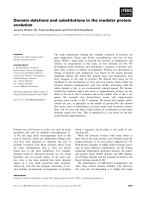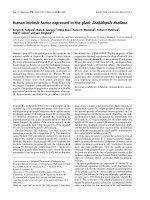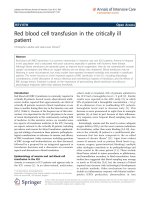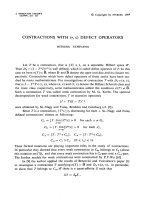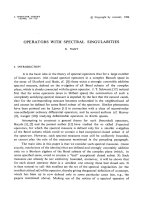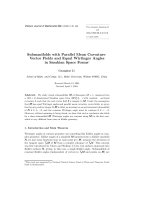Báo cáo toán học: "Graphs with chromatic roots in the interval (1, 2)" doc
Bạn đang xem bản rút gọn của tài liệu. Xem và tải ngay bản đầy đủ của tài liệu tại đây (97.23 KB, 7 trang )
Graphs with chromatic roots in the interval (1, 2)
Gordon F. Royle
School of Computer Science & Software Engineering
University of Western Australia
Nedlands WA 6009, Australia
Submitted: Apr 18, 2007; Accepted: Aug 22, 2007; Published: Aug 31, 2007
Mathematics Subject Classification: 05C15
Abstract
We present an infinite family of 3-connected non-bipartite graphs with chromatic
roots in the interval (1, 2) thus resolving a conjecture of Jackson’s in the negative.
In addition, we briefly consider other graph classes that are conjectured to have no
chromatic roots in (1, 2).
1 Introduction
The chromatic polynomial of a graph G is the function P(G, k) that counts the number of
k-colourings of G when k is a natural number. It is well known that P (G, k) is a polynomial
with degree equal to the number of vertices of G, and there is an extensive literature on the
relationship between the properties of a graph and its chromatic polynomial. For general
backgound information and references to much of this literature we refer the reader to
the recent book on chromatic polynomials by Dong, Koh & Teo [2].
One aspect of the study of chromatic polynomials that has received considerable recent
interest is the problem of the distribution of the chromatic roots of a graph — that is, the
real and complex zeros of the chromatic polynomial. In a comprehensive survey paper,
Jackson [4] describes much of this work and presents a number of open problems and
conjectures. One of these conjectures arises from attempts to extend the portion of the
real line on which the behaviour of the chromatic polynomial is completely understood.
In particular, we have complete knowledge of the real roots of P (G, x) for all values of
x ≤ 32/27, as described in the following fundamental theorem.
Theorem 1 (See Jackson [4]). If G is a loopless graph with n vertices, c components
and b blocks which are not isolated vertices, then
(a) P (G, x) is non-zero with sign (−1)
n
for x ∈ (−∞, 0);
the electronic journal of combinatorics 14 (2007), #N18 1
Figure 1: The graph X(3, 3)
(b) P (G, x) has a zero of multiplicity c at x = 0;
(c) P (G, x) is non-zero with sign (−1)
n+c
for x ∈ (0, 1);
(d) P (G, x) has a zero of multiplicity b at x = 1;
(e) P (G, x) is non-zero with sign (−1)
n+c+b
for x ∈ (1, 32/27] ≈ (1, 1.185].
For general graphs, the constant 32/27 cannot be replaced by anything larger because
Jackson [3] produced a family of graphs with real chromatic roots arbitrarily close to
32/27. However for certain classes of graphs the chromatic-root-free interval can be ex-
tended — for example, Thomassen [6] showed that graphs with a hamiltonian path have
no chromatic roots in (1, 1.29559 . . .). Both Jackson’s graphs with chromatic roots close to
32/27 and Thomassen’s graphs with chromatic roots close to 1.29559 have cutsets of size
two, raising the question of whether the chromatic-root-free interval can be significantly
extended for 3-connected graphs. Elementary continuity arguments show that bipartite
graphs of odd order have a chromatic root in (1, 2) and these can have arbitrarily high
connectivity, but Jackson conjectured that these were the only such examples.
Conjecture 2 (Jackson [3, 4]). A 3-connected graph that is not bipartite of odd order
has no chromatic roots in (1, 2).
In this paper we demonstrate that this conjecture is false, by providing an infinite
family of 3-connected non-bipartite graphs with chromatic roots in (1, 2), and then briefly
discuss some alternative conjectures.
2 An infinite family of counterexamples
We consider a family of graphs whose smallest member is the 11-vertex graph X(3, 3)
shown in Figure 1. It is clear by inspection that X(3, 3) is 3-connected and not bipartite
the electronic journal of combinatorics 14 (2007), #N18 2
Figure 2: One type of colouring of X(s, t)
and it is sufficiently small that its chromatic polynomial can be easily computed. The
result of this computation is that P (X(3, 3), x) = x(x − 1)(x − 2)Q(x), where
Q(x) =
x
8
− 17 x
7
+ 137 x
6
− 677 x
5
+ 2228 x
4
− 4969 x
3
+ 7284 x
2
− 6363 x + 2509
,
which has real roots at r
1
≈ 1.90263148 and r
2
≈ 2.42196189. Therefore we conclude that
Jackson’s conjecture is false.
Now let X(s, t) be the graph obtained by replacing the two independent sets of size
three labelled S and T in Figure 1 by independent sets of size s ≥ 3 and t ≥ 3 respectively.
Our aim is to prove the following theorem:
Theorem 3. The graph X(s, t) is 3-connected and not bipartite and if s, t ≥ 3 are both
odd, then it has a chromatic root in (1, 2).
It is clear that X(s, t) is 3-connected and not bipartite, and so all that remains is
to prove the claim about its chromatic roots. The chromatic polynomial of X(s, t)
can be calculated by considering all the possible types of colouring of the five vertices
{v
0
, v
1
, v
2
, v
3
, v
4
} outside S and T . For example, Figure 2 represents colourings where
three distinct colours a, b and c are used, v
0
, v
1
and v
3
are coloured a and v
2
and v
4
are
coloured b and c respectively. If we have a palette of x colours to choose from, then there
are x choices for a, x − 1 choices for b and x − 2 choices for c. Then the vertices of S can
be coloured anything other than a and so there are (x − 1)
s
possibilities and the vertices
of T can be coloured anything other than {a, b, c} leaving (x − 3)
t
possibilities. Thus the
colourings of this particular type contribute
x(x − 1)(x − 2)(x − 1)
s
(x − 3)
t
(1)
to the chromatic polynomial.
It is straightforward, though tedious, to confirm that there are exactly 27 different
types of colouring for these five vertices, and therefore the chromatic polynomial of X(s, t)
the electronic journal of combinatorics 14 (2007), #N18 3
is the sum of 27 terms of a similar form to the one shown in (1), although some of terms can
be combined due to the symmetries of the situation. Overall however, the final expression
is both complicated and unenlightening and more suitable for a symbolic algebra package
such as Maple than for presentation in this paper. Fortunately however, we only need a
small portion of the chromatic polynomial in order to deduce enough information for our
purposes.
Lemma 4. If s, t > 1 then the derivative of P (X(s, t), x) evaluated at x = 2 is
P
(X(s, t), 2) = 2
(−1)
s
+ (−1)
t
+ (−1)
s+t
.
In particular, when either s or t is odd, then
P
(X(s, t), 2) = −2.
Proof. The derivative of P (X(s, t), x) can be obtained by differentiating each of the 27
terms in the chromatic polynomial separately. However as our concern is only with the
value of this derivative at x = 2, we can ignore any terms with factors of (x − 2)
s
or
(x − 2)
t
(or both) as these make no contribution to the final value (recall that s, t > 1).
Therefore we need only consider the types of colouring that use either 1 or 3 colours on
{v
0
, v
1
, v
3
} and similarly for {v
0
, v
2
, v
4
}. These colourings contribute the following five
terms to the chromatic polynomial:
x (x − 1) (x − 2) (x − 1)
s
(x − 3)
t
x (x − 1) (x − 2) (x − 3)
s
(x − 3)
t
x (x − 1) (x − 2) (x − 3)
s
(x − 1)
t
2 x (x − 1) (x − 2) (x − 3) (x − 3)
s
(x − 3)
t
x (x − 1) (x − 2) (x − 3) (x − 4) (x − 3)
s
(x − 3)
t
(For example, the second term x (x − 1) (x − 2) (x − 3)
s
(x − 3)
t
counts the colourings of
the type shown in Figure 3.) The sum of the last two terms is
x (x − 1) (x − 2)
2
(x − 3)
1+s+t
and so these also make no net contribution to the derivative of P (X(s, t), x) evaluated at
x = 2. Differentiating the remaining three terms and substituting x = 2 gives the stated
result, and the second part follows immediately.
When s and t are both odd, the graph X(s, t) has an odd number of vertices and as it
is 3-connected, the chromatic root at x = 1 has multiplicity one. Therefore P (X(s, t), x)
is negative on (−∞, 0), positive on (0, 1) and negative on some small interval (1, 1 + α).
However by Lemma 4, the chromatic polynomial is decreasing as it passes through the
root at x = 2 and so is positive on some small interval (2 − β, 2). It follows by continuity
that the chromatic polynomial has a root in the interval (1, 2).
We can perform a similar analysis on the graphs obtained by adding the single edge
v
1
v
4
to X(s, t) with the following result.
the electronic journal of combinatorics 14 (2007), #N18 4
Figure 3: A type of colouring that contributes to the derivative
Theorem 5. If Y (s, t) is the graph obtained from X(s, t) by joining v
1
and v
4
then
P
(Y (s, t), 2) = 2
(−1)
s
+ (−1)
t
+ (−1)
s+t
and hence when s, t are both odd, the chromatic polynomial of Y (s, t) also has a chromatic
root in (1, 2).
3 Questions and Conjectures
The results of the previous section raise two immediate questions:
Question 6. What is the largest δ such that (1, δ) is a chromatic-root-free interval for
3-connected non-bipartite graphs?
Question 7. Which classes of graphs have no chromatic roots in (1, 2)?
The first question is asking whether there are other 3-connected non-bipartite graphs
with chromatic roots smaller than 1.90263148 and if so, how much smaller. The first
obvious place to look is to see what happens when varying s and t for X(s, t) and Y (s, t).
However the proof of our main theorem is an existence proof and gives us no clues as
to the actual location of the chromatic roots other than that they are in (1, 2). However
computational evidence (detailed in Table 1 and Table 2) suggests that X(3, 3) contributes
the smallest chromatic roots in these families.
A related question is obtained by not excluding bipartite graphs and just requiring
3-connectivity. In this case, the smallest known chromatic root in (1, 2) is approximately
1.7811, which comes from the complete bipartite graph K
3,4
.
With respect to the second question, a number of different classes have been consid-
ered by various authors. As all (previously) known examples of 2-connected graphs with
chromatic roots in (1, 2) had cutsets of size two or were bipartite of odd order, it was
the electronic journal of combinatorics 14 (2007), #N18 5
s\t 3 5 7 9 11 13 15 17 19
3 1.9026 1.9223 1.9342 1.9424 1.9484 1.9531 1.9568 1.9599 1.9625
5 1.9372 1.9464 1.9527 1.9574 1.9611 1.9640 1.9665 1.9685
7 1.9539 1.9591 1.9630 1.9660 1.9685 1.9706 1.9723
9 1.9636 1.9669 1.9696 1.9717 1.9735 1.9751
11 1.9699 1.9722 1.9741 1.9757 1.9771
13 1.9743 1.9761 1.9775 1.9788
15 1.9777 1.9790 1.9801
17 1.9802 1.9813
19 1.9822
Table 1: Chromatic root of X(s, t) to 4 decimal places
s\t 3 5 7 9 11 13 15 17 19
3 1.9131 1.9294 1.9397 1.9468 1.9521 1.9563 1.9596 1.9624 1.9648
5 1.9420 1.9500 1.9556 1.9598 1.9631 1.9659 1.9681 1.9700
7 1.9566 1.9613 1.9648 1.9676 1.9699 1.9718 1.9734
9 1.9653 1.9684 1.9708 1.9728 1.9745 1.9759
11 1.9711 1.9733 1.9751 1.9766 1.9778
13 1.9752 1.9768 1.9782 1.9794
15 1.9783 1.9796 1.9807
17 1.9807 1.9817
19 1.9827
Table 2: Chromatic root of Y (s, t) to 4 decimal places
natural to conjecture that these were the only such graphs. However, with the consider-
able advantage of hindsight, the condition “3-connected and non-bipartite” is somewhat
unsatisfactory because an ideal condition would intrinsically exclude odd order bipartite
graphs rather than explicitly omit them from consideration.
One such condition was given by Thomassen [5], who conjectured that hamiltonian
graphs do not have chromatic roots in (1, 2). Recall that a graph G is said to be 1-tough
if there is no subset S of its vertices such that G − S has more than |S| components, and
that a hamiltonian graph is necessarily 1-tough. Now X(s, t) and Y (s, t) both have the
property that they have sets of 3 vertices (e.g. {v
0
, v
1
, v
3
}) whose removal leaves more
than 3 components, and therefore they are not 1-tough and hence not hamiltonian. Thus
Thomassen’s conjecture remains open.
In recent work, Dong & Koh [1] have found a number of sufficient conditions for graphs
to have no chromatic roots in (1, 2), such as the following useful result.
Theorem 8 (Dong & Koh [1]). If the graph G has a hamiltonian path v
1
∼ v
2
∼ · · · ∼
v
n
such that for all i > 2, the vertex v
i
has at least one neighbour in {v
1
, v
2
, . . . , v
i−2
} (i.e.
at least two “back neighbours” in total including v
i−1
) then G has no chromatic roots in
(1, 2).
the electronic journal of combinatorics 14 (2007), #N18 6
One feature common to all of the graphs that Dong & Koh can prove to be chromatic-
root-free in the interval (1, 2) is that they satisfy a condition that is a weaker version
of 1-toughness, namely that they have no independent sets S whose removal leaves more
than |S| components. This suggests that maybe it is the toughness of hamiltonian graphs
(rather than the actual cycle itself) that is important, and along these lines Dong & Koh
have made the following interesting strengthening of Thomassen’s conjecture.
Conjecture 9 (Dong & Koh [1]). If G is a graph with a chromatic root in (1, 2), then
G has an independent set S such that
c(G − S) > |S|
where c(G − S) denotes the number of connected components of G − S.
References
[1] Dong, F. M., and Koh, K. M. On graphs having no chromatic zeros in (1, 2). SIAM
J. Discrete Math. 20, 3 (2006), 799–810 (electronic).
[2] Dong, F. M., Koh, K. M., and Teo, K. L. Chromatic polynomials and chromaticity
of graphs. World Scientific Publishing Co. Pte. Ltd., Hackensack, NJ, 2005.
[3] Jackson, B. A zero-free interval for chromatic polynomials of graphs. Combin. Probab.
Comput. 2, 3 (1993), 325–336.
[4] Jackson, B. Zeros of chromatic and flow polynomials of graphs. J. Geom. 76, 1-2
(2003), 95–109. Combinatorics, 2002 (Maratea).
[5] Thomassen, C. On the number of Hamiltonian cycles in bipartite graphs. Combin.
Probab. Comput. 5, 4 (1996), 437–442.
[6] Thomassen, C. Chromatic roots and Hamiltonian paths. J. Combin. Theory Ser. B
80, 2 (2000), 218–224.
the electronic journal of combinatorics 14 (2007), #N18 7
